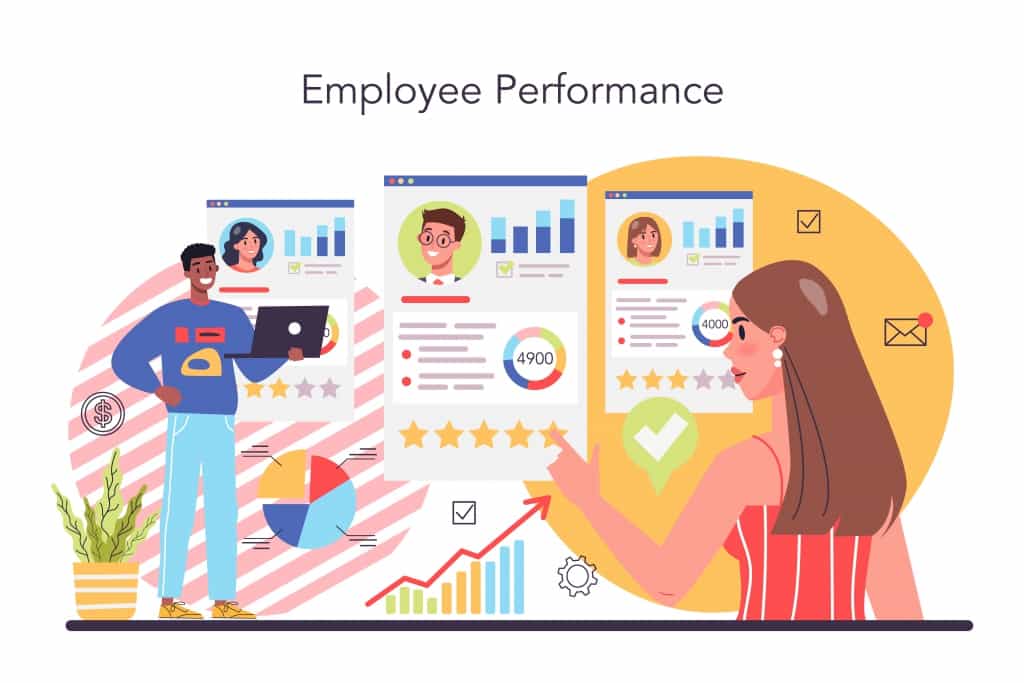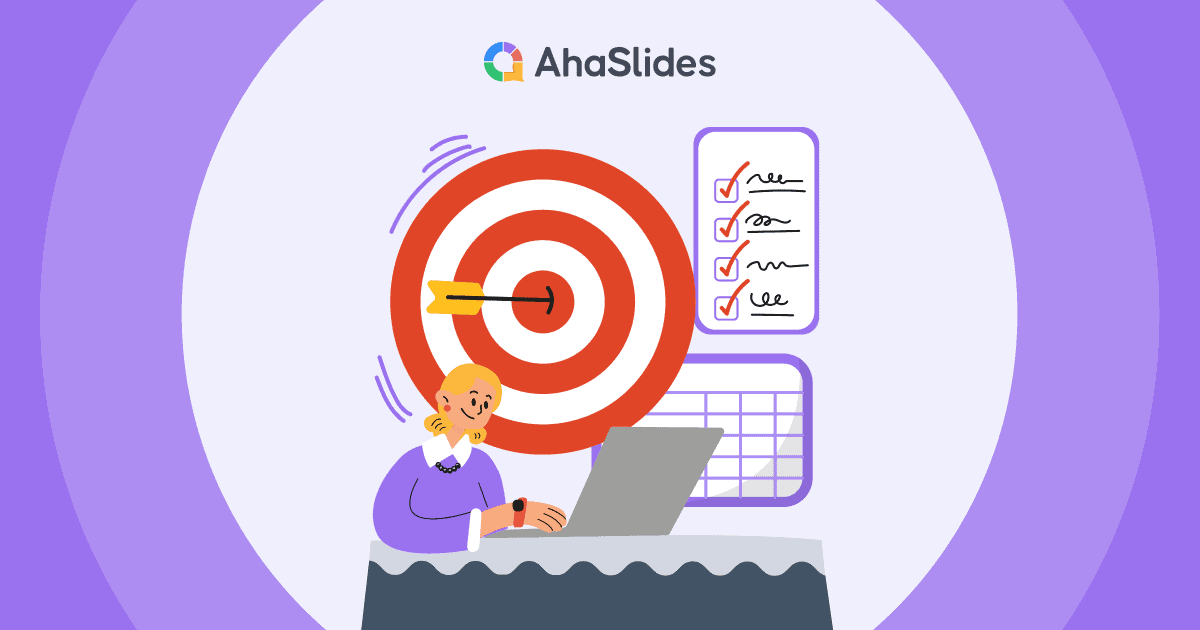従業員の業績評価 組織の従業員を効果的に管理するためには、人事評価が不可欠です。マネージャーが従業員のパフォーマンスを評価するのに役立つだけでなく、従業員にフィードバックやキャリア開発に関する提案を提供することも可能になります。
しかし、評価方法やツールは多種多様であるため、どこから始めれば良いのか迷ってしまうことがあります。この記事では、従業員の業績評価のメリットと種類を詳しく解説し、評価を始めるためのヒントをご紹介します。
目次
より良いエンゲージメントのためのヒント
人事評価とは?
前 従業員のレビューについて知っておく必要があります
社員の業績評価!従業員業績評価は「従業員業績レビュー」とも呼ばれ、通常は 1 年間の一定期間にわたる従業員の業績を評価するプロセスです。
これは、組織が従業員の能力とパフォーマンスを評価し、目標の達成、スキル、リーダーシップ能力、職場での従業員の態度に関する情報を提供する方法です。
これらの評価は通常、従業員の上司または直属の上司によって実行され、次の 3 つの要素が含まれます。
- 前年に従業員に設定された目標を評価します。
- 従業員が直面している問題と課題を特定します。
- 来年の計画や改善点を提案します。
これらの評価の結果は、将来の従業員の賞、インセンティブ、または開発に関する決定を行うために頻繁に利用されます。

従業員の業績評価が重要な理由
従業員のパフォーマンス評価は、組織とその従業員の両方にとってメリットがあるため、重要です。 主なメリットは次のとおりです。
従業員のメリット
- の理解を深める 仕事の目標: パフォーマンス評価は、従業員が仕事の目標をよりよく理解し、仕事の方向性を定め、仕事をよりよく完了するために何をする必要があるかを知るのに役立ちます。
- 成長と発展の機会: 評価は、従業員に自分の長所と改善すべき分野に関するフィードバックを提供し、成長と発展の機会を特定します。
- サポートの機会: 評価は、従業員が自分の強みと改善すべき領域を理解するのに役立つだけでなく、従業員が仕事のパフォーマンスを向上させるために必要なリソースとサポートを推奨するのにも役立ちます。
- 表彰と報酬: 従業員のパフォーマンス評価は、従業員の勤勉さと成果を認識して報いる方法としても機能し、高いレベルでパフォーマンスを継続するように動機付けることができます。
- 強化されたコミュニケーション: パフォーマンス評価は、従業員とそのマネージャーがより効果的にコミュニケーションをとる機会でもあります。 これにより、より強力な作業関係を構築し、組織内の信頼とコラボレーションを強化できます。

雇用主にとってのメリット
- 従業員の業績評価: 名前が示すように、従業員のパフォーマンス評価は、雇用主が仕事の質を評価し、従業員のパフォーマンスを測定するのに役立ちます。 これは、組織に積極的に貢献する才能のある従業員を特定するのに役立ちます。
- 従業員管理: これらの業績評価は、雇用主に従業員のパフォーマンスに関する情報を提供し、より効果的な人材管理に役立ちます。さらに、各従業員の能力開発とキャリアアップに関して適切な判断を下すことも可能です。
- 従業員のやる気を引き出す: 業績評価は、従業員の職場でのモチベーションを高め、従業員が評価され、能力開発をサポートされていると実感できるようにします。これにより、従業員の仕事へのコミットメントと貢献度が高まり、業務効率が向上し、組織の製品とサービスの品質が向上します。
- 透明性を高める: 従業員の業績評価は、組織の透明性と公平性を高めるのに役立ちます。 また、プロフェッショナルな職場環境を作り、従業員からの不満を回避します。
従業員の業績評価をどのように準備しますか?
従業員の業績評価を効果的に実施するには、次の 8 つのステップが必要です。

1/ 明確な評価基準を定義する
評価を開始する前に、従業員が評価される基準を定義し、それらが明確で職務に関連していることを確認する必要があります。
たとえば、従業員(会計士)のパフォーマンスを評価する場合は、次の評価基準を定義する必要があります。
- 簿記の過程で正確かつ完全。
- 会計専門職に関連する新しい会計スキルと規制を解釈、理解、適用する能力。
- 所定の品質基準に従って、時間通りに経理業務を完了します。
- 迅速に対応し、会計関連の問題を専門的に解決します。
これらの基準は、会計士の職務と職務に求められるスキルに基づいて設定されています。また、これらの基準は明確かつ具体的であるため、正確な評価結果が得られます。
2/ 関連情報を収集する
パフォーマンス メトリック、プロジェクトのフィードバック、その他の関連文書など、従業員のパフォーマンスに関連する情報と文書を収集する必要があります。
この情報は、正確かつ最新で、評価に関連するものでなければなりません。
3/ 業績評価票の作成
正確で適切な評価フォームは、問題の発生を最小限に抑え、評価を迅速に行うのに役立ちます。 一方で、同じ立場の社員を評価する共通の形があれば、透明性、客観性、公平性が確保されます。
評価シートには、作業品質基準、作業プロセス、期待される目標、および従業員の改善点が含まれます。
4/ 業績評価の種類を選択する
従業員のパフォーマンスを評価する方法はいくつかあります。 それぞれに異なる利点があり、特定の評価目標に対して機能します。
- たとえば、従業員の業績を多面的に把握する必要がある場合は、360 度評価方法を選択できます。 逆に、従業員を経時的に評価したい場合は、中間評価が適切な選択かもしれません。
この記事の次のセクションを参照して、ビジネスまたは組織に適したパフォーマンス評価方法を選択してください。
5/議題を作成し、従業員に通知する
評価会議の前に、議論するトピックと会議の目標をまとめたアジェンダを作成してください。これにより、会話がスムーズに進むようになります。
次に、このアジェンダを従業員に送信して通知し、評価時間が従業員の勤務スケジュールと一致していることを確認する必要があります。
さらに、従業員には、評価プロセスに関する指示と説明を提供する必要があります。
6/ 公平性と客観性の確保
評価にあたっては、感情に基づく判断や不合理な結果を避け、公平性と客観性を確保する必要があります。
- 例えば、従業員のコミュニケーションスキルを評価する場合、会話やメールの録音といった客観的な手段を用いて、その有効性を測るべきです。また、全従業員に対して同一の評価基準が公平かつ公平であることを確認する必要があります。
客観的かつ公正に評価することで、従業員の育成と昇進に関する意思決定を行うための正確で信頼できる評価基準が得られます。
7/ フィードバックと評価
従業員の現状とパフォーマンスを評価した後は、より効果的かつ効率的に業務を遂行できるよう、フィードバックを提供することが不可欠です。このフィードバックは建設的で具体的なもので、従業員の強みと改善すべき点を明確に示す必要があります。明確な改善指示を得ることで、従業員は自己成長とキャリアアップに向けて努力することができます。
また、トレーニング プログラム、コーチング、および従業員をサポートするために必要なリソースを提供することもできます。
また、評価後の表彰には、賞与、昇給、福利厚生、称賛、表彰などさまざまな形があります。 認識は、従業員が組織によって評価され、感謝されていることを示しています。
チェックアウト日: 同僚へのフィードバックの例
8種類の人事評価方法(+具体例)
以下は、その性質に基づいて分類された8種類の従業員業績評価です。

正式なレビュー
#1 – 中間レビューの例
中間レビューとは、通常6月または7月に年度の途中に実施される従業員の業績評価の一種です。これは、管理者と従業員が年間目標の達成状況を評価し、目標達成のために解決すべき課題を特定する機会です。
さらに、このレビューは、従業員が自分の仕事のパフォーマンスをよりよく理解し、下半期に調整する方向性を見つけるのに役立ちます。
使用することにより、 中間レビューの例、マネージャーは効果的な中間レビューを実施する方法をよりよく理解でき、従業員はレビュープロセスの準備と参加の方法をよりよく理解できます。
これらの例は、中間レビューの質問、目的、および回答の貴重なガイドを提供し、マネージャと従業員がレビュー プロセスを成功させるために必要なツールを確実に備えられるようにします。
#2 – 年末レビューの例
年度末レビューは、毎年 XNUMX 月または XNUMX 月上旬に行われる業績評価です。 これにより、従業員は、業績、改善領域、来年の成長の機会など、年間を通してのパフォーマンスの概要を知ることができます。
年末レビューの例 従業員のパフォーマンスを評価し、改善すべき分野を特定し、翌年の目標を設定し、従業員の組織への全体的な貢献について話し合うためのガイドが含まれます。
これを使用することで、マネージャーと従業員が協力して、効果的で成功したレビューを確実に行うことができます。

#3 – 評価コメント
効果的な評価コメントを提供することは、従業員がパフォーマンスに関する貴重なフィードバックを確実に受け取るために不可欠です。 明確で建設的なフィードバックは、従業員が継続的に改善し、組織の目標を達成するよう動機づけることができます。
効果がない 評価コメントの場合、従業員は、自分のパフォーマンスがどの程度優れているか、または改善するために何をする必要があるかを明確に理解していない可能性があります。 これは、従業員の間で混乱と不満につながる可能性があり、モチベーションと生産性に悪影響を及ぼす可能性があります。
したがって、管理者は詳細で正確な評価コメントを提供して、従業員が改善と成長に役立つ貴重なフィードバックを受け取るようにする必要があります。
#4 – パフォーマンス評価の例
パフォーマンス評価は、設定された目標に対する個人、グループ、または組織のパフォーマンスを測定および評価するプロセスです。 長所と短所を特定し、フィードバックを提供し、パフォーマンスを改善するための計画を作成するのに役立ちます。
ボーマン 性能評価例 マネージャーと従業員は、効果的なパフォーマンス評価を実施し、有意義な目標を設定し、建設的なフィードバックを提供し、改善のための行動計画を作成する方法をよりよく理解できます。
これらの例により、組織は業績評価が公平で、一貫性があり、透明であることを保証することもできます。
チェックアウト日: 評価のための作業目標の例

非公式のレビュー
#5 – マネージャーのフィードバック例
マネージャーにフィードバックを提供することは、組織の成功にとって非常に重要です。 効果的なフィードバックは、改善すべき領域を特定し、自分の強みを認識し、チーム メンバーから自分がどのように認識されているかを理解するのに役立ちます。
従業員がマネージャーにフィードバックを提供できるようにするために、 マネージャーのフィードバックの例 コミュニケーション スキル、意思決定能力、リーダーシップ スタイル、および全体的なパフォーマンスに関する具体的なコメントを含めます。
これらのフィードバックの例を参照することで、マネージャーと従業員は前向きな職場環境を作ります。
#6 – 同僚へのフィードバックの例
ポジティブで生産的な職場環境を作るには、同僚にフィードバックを提供することが不可欠です。 フィードバックは、個人が自分の長所と短所を理解するのに役立ち、パフォーマンスを改善する機会を提供します。 また、同僚間の信頼関係を築き、関係を強化するのにも役立ちます。
同僚へのフィードバックの例 建設的な批判、積極的な強化、改善のための具体的な提案が含まれます。 これらの例を適用することで、ビジネスでオープンなコミュニケーションと相互尊重の文化を築くことができます。
これは、コラボレーションの強化、士気の向上、そして最終的に組織の成果の向上につながる可能性があります。

複数評価者によるレビュー
#7 – 360度フィードバック
360 度フィードバックは、マネージャー、同僚、部下、さらには外部の関係者など、複数のソースからフィードバックを収集して、個人のパフォーマンスの総合的なビューを提供するレビュー プロセスです。
これは、改善すべき領域を特定し、強みを認識し、個人が組織に与える影響をより総合的に理解するための効果的な方法です。
360度フィードバック このタイプの評価を効果的に実施するのに役立ち、リーダーシップの資質、問題解決スキル、コミュニケーション スキルなどに関するフィードバックの例が含まれています。
セルフレビュー
#8 – 自己評価の例
自己評価は、多くの場合、全体的なパフォーマンス評価システムの一部として、従業員が自分の仕事のパフォーマンスを評価するプロセスです。 従業員は、自分の成果、課題、改善すべき領域について考える機会を得ることができます。
自己評価は、従業員が自分のパフォーマンスと開発の所有権を取得できるようにするために不可欠です。
また、参照することで、 自己評価の例マネージャーは、従業員の自己認識と改善点の特定能力を把握することができます。これにより、従業員とマネージャー間のオープンなコミュニケーションと信頼が促進され、パフォーマンスと仕事への満足度の向上につながります。

主要なポイント(要点)
従業員のパフォーマンスを評価することは非常に重要です。 従業員が能力を開発し、組織に効果的に貢献できるようにする役割があります。 ニーズに合わせた8種類の人事評価方法は次のとおりです。
- 中間レビューの例 – フィードバックを提供し、改善すべき領域を特定し、目標を設定するために、年の半ばに実施されます。
- 年末レビューの例 – 従業員の業績と改善点の概要、および次年度の目標の設定。
- 鑑定コメント – 従業員の向上を支援するために、正式な業績評価プロセスで建設的なフィードバックが提供されます。
- 性能評価例 – 設定された目標に対して従業員のパフォーマンスを評価し、強みと改善の余地を特定します。
- マネージャーのフィードバックの例– マネージャーが従業員のパフォーマンス、行動、生産性に関して提供するフィードバック。
- 同僚へのフィードバックの例 – 同僚が他の同僚に対してパフォーマンス、行動、または生産性に関して提供するフィードバック。
- 360度フィードバck – 従業員の上司、同僚、部下、顧客からのフィードバックを収集する包括的な業績評価。
- 自己評価の例 – 従業員は自身のパフォーマンスを評価し、強みと改善すべき点に関するフィードバックを提供します。
従業員のパフォーマンスをさらに向上させるには、 あはスライド'インタラクティブ機能と 既製のテンプレート あなたのチームを引き付けるために!
よくある質問
社員の業績評価とは?
従業員業績評価とは、通常 1 年間の一定期間にわたる従業員の業績を評価するプロセスです。
従業員の業績評価の目的は何ですか?
従業員のパフォーマンス評価の目的は、従業員に仕事に関するフィードバックを提供し、パフォーマンスを向上させ、スキルを開発することです。 これらの評価の結果は、将来の従業員の賞、インセンティブ、または開発に関する決定を下すために利用されます。
従業員の業績評価は誰が行うのですか?
従業員の業績評価は、通常、評価対象の従業員と緊密に連携するマネージャーまたは監督者によって実施されます。 ただし、場合によっては、従業員がチームまたは同僚のグループによって評価されることもあります。









